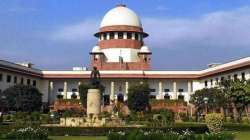Centre justifies amending Article 370 in Supreme Court
The Centre has filed an affidavit in the Supreme Court, justifying the revocation of Article 370 from Jammu and Kashmir by saying that the power under Article 370(1)(d) of the Constitution could validly be exercised even after the dissolution of the Constituent Assembly of the erstwhile state.

The Centre has filed an affidavit in the Supreme Court, justifying the revocation of Article 370 from Jammu and Kashmir by saying that the power under Article 370(1)(d) of the Constitution could validly be exercised even after the dissolution of the Constituent Assembly of the erstwhile state.
"Since there was no Constituent Assembly at that particular time, the mechanism under Article 367 and Article 370(1)(d) was used," said the Centre in its response to a clutch of petitions filed in the Supreme Court challenging the decision in August to revoke Article 370.
The Centre cited the judgment in Sampat Prakash vs State of Jammu and Kashmir, (1969) 2 SCR 365, by a Constitution bench of the top court, affirmed the view expressed in PuranlalLakhanpal matter, and held that the dissolution of the Constituent Assembly of Jammu and Kashmir would not render Article 370 of the Constitution inoperative or ineffective.0
"In other words, it was held that the power under Article 370(1)(d) of the Constitution could validly be exercised even after the dissolution of the Constituent Assembly of Jammu and Kashmir," contended the Centre.
The petitions have challenged the legal route adopted by the Centre, which includes the use of presidential powers. The Centre contested it by contending that the power to amend Article 370, represents an important part of the constitutional setup wherein the framers of the constitution, realizing the importance of a united Union, reserved such powers to the Parliament. "In this regard, it is submitted that the powers of the Union Parliament, with regard to the nature of powers under Article 3 i.e. alteration of state boundaries, bifurcation, new States, etc, is very wide in nature", said the affidavit claiming the assertions of the petitioners were "untenable".
Elaborating on the constitutional mechanism, the Centre claimed that as per Article 356, the President by proclamation assumes all the functions/powers of the state government/Governor except the legislative power of the state Assembly. However, the President under Article 356(1)(b) can declare that the legislative powers of the state would be exercised by the Parliament.
Citing historical reference, the Centre said in the year 1952, Article 370 itself was also modified, in exercise of powers under Article 370(3) and consistent with the proviso to Article 370(3), substituting 'Sadar-e-Riyasat' for 'Maharaja' and submitted that thereafter, "Sadar-i-Riyasat" was substituted to mean "Governor". It submitted that "since there was no Constituent Assembly at that particular time, the mechanism under Article 367 and Article 370(1)(d) was used. It may be relevant to note that Article 367, was applied to the then State of Jammu and Kashmir, with the following modifications, by way of the amended Constitution (Application to Jammu and Kashmir) Order, 1954".
Justifying the Governor's rule in the state for the 6-month period from June 20, 2018, it said that this would expire on December 19, 2018. "At the same time, Assembly elections could not be held in the State by this date, as a period of only about a month was available after November 21, 2018. In these circumstances, pursuant to a report received from the Governor of the state, the President of India assumed all the functions of the government of Jammu and Kashmir by issuing a Proclamation under Article 356 of the Constitution."
ALSO READ | Abrogation of Article 370 will safeguard future of J&K's children: Piyush Goyal
ALSO READ | We diluted Article 370 twelve times without controversy: Congress